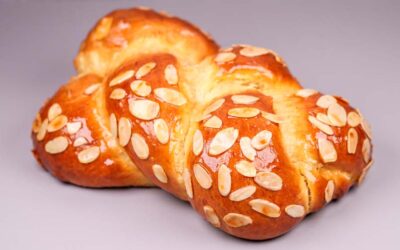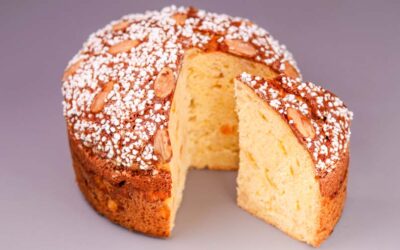Pandoro is a light Italian Christmas bread flavoured with citrus. This no-knead slow-fermented version is perfect for a beginner or anyone who does not have a lot of free time.
With a super soft and light crumb and lots of lemon and orange peel it will be the perfect festive bread to impress your family or friends. But I won’t judge if you decide not to share it!
Follow my simple instructions for guaranteed success with this impressive bake. The recipe allows for a lot of flexibility on how long to ferment it and when to bake it. You could keep the dough in your fridge from 12 hours up to 24 hours. The long cold proof gives this bread a wonderful flavour and it will make it stay fresh for longer.
There is no need to use a temperature probe for this recipe either as most of the proofing is done in the fridge. You will need one crucial piece of equipment to make this bread look the way it should – the pandoro mould. Find it in my Amazon shops linked below. But you can simply make it in a tall cake tin instead as it will still taste the same.
Be sure to check out the Festive Breads page for many more Christmas bread recipes.
Watch the video down below for detailed instructions.
Ingredients
For the preferment (sponge) –
50g (1.75oz) strong white bread flour
50g (1.75oz) room temperature water
2g (0.07oz) instant dry yeast or 2.4g (0.08oz) active dry yeast or 6g (0.21oz) fresh yeast
For the first dough –
125g (4.4oz) strong white bread flour
30g (1oz) sugar
20g (0.7oz) soft butter
1 egg, around 50g (1.75oz)
1 egg yolk, around 20g (0.7oz)
For the second (final) dough –
125g (4.4oz) strong white bread flour
70g (2.45oz) sugar
6g (0.21oz) salt
10g (0.35oz) vanilla paste/syrup
1 egg, around 50g (1.75oz)
Zest of two lemons
Zest of two oranges
100g (3.5oz) butter for laminating. Flattened between layers of baking paper. *See video.
Icing sugar to dust
Method
- Make the sponge. Mix the water, yeast, and flour until there is no dry flour left. Cover and ferment for 1 hour or until tripled in volume.
- Make the first dough. Add the egg, egg yolk, sugar, and butter to the sponge. Mix well to dissolve the sugar and to distribute the ingredients evenly. Add the flour and mix well until there is no dry flour left. Cover and cold proof for at least 12 hours, but you can leave it in the fridge for up to 24 hours.
- Make the final dough. Add the egg, salt, citrus zest, sugar, and vanilla paste to the first dough. Mix well. It is important to add the ingredients in the right order and to mix them well in stages to insure even distribution of ingredients throughout the dough because we are not kneading it.
- Add the flour and mix again until there is no more dry flour left. Then mix for another minute by going around the bowl with your scraper to make sure everything is nice and even.
- Cover and cold proof for 12 – 24 hours.
- Laminate the dough. This process is like laminating croissant dough, but not quite as precise or technical. Dust the dough with flour and take it out of the bowl. Place it on the table with the smooth side down. Flatten the dough to fit the butter. Lay the butter square onto the dough and seal it up by meeting the corners in the middle. Pinch the seams together.
- Roll the dough out to twice its length. Fold one side into the middle. Fold the other side to meet the first one in the middle. Pinch the seam together and fold the dough in half following the seam.
- Cover and chill for 15 minutes.
- Roll the dough out to 1.5 times its length in the direction of the two open ends. This time fold one third over and the remaining third over the first.
- Cover and chill for 15 minutes. While the dough is chilling prepare the mould. Rub the inside with butter making sure to cover the whole surface. Dust with flour and shake out the excess. This will prevent the loaf from sticking.
- Shape the loaf. Flatten the dough using some flour to prevent it from sticking. Fold the edge over the middle going around in a circle until you have a nice tight ball.
- Pick the dough ball up and shape the smooth side of it into a cone to fit the mould better. *See the video!
- Place the dough into the mould. Cover and cold proof for 12 – 24 hours. Alternatively, you can leave it to ferment at room temperature until it reaches the top of the mould and bake it on the same day. The proofing time will depend on the temperature of your kitchen. Anywhere between 6 – 8 hours should do it.
- If you cold proof the dough like I did, then take it out of the fridge for the final proof which will take around 12 hours depending on the temperature of your kitchen. You can easily take it out in the morning and go to work. It should be risen by the time you get back. That is the beauty of this recipe as you do not have to tend to this dough at all.
- One hour before baking preheat your oven to 160C (320F) fan on.
- Bake the loaf for 15 minutes. Remove it from the oven and cover with tin foil to prevent the top from getting too dark. Bake it for another 35 minutes.
- Leave to set in the tin for 15 minutes before removing. Leave to cool down completely.
Dust the loaf generously with icing sugar before serving. Enjoy!
Keep in mind that the conditions in each kitchen are different, so fermentation times may vary for you. It is up to the baker to control the bread and react accordingly.
Your oven may be different too, so your baking time may vary.
Watch the video here



